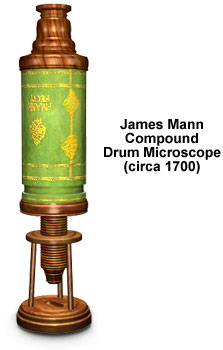James Mann Compound Drum Microscope
James Mann, a British optician who apprenticed under Thomas King and Sir Isaac Newton, created the compound drum microscope featured below around 1700. The instrument is described and illustrated in a short treatise entitled Microscopes to the End of the Nineteenth Century by Frederick W. Palmer and Aderji B. Sahiar.

Based on earlier Continental designs of compound microscopes, Mann fashioned the handsome tripod drum microscope in his London shop using cardboard, vellum, glass, and wood. The instrument's ocular and objective, which screws into a two-inch long nosepiece, are biconvex lenses and a similar lens is located between the eyepiece and nosepiece. Sliding the drawtubes of the microscope enable adjustment of the magnification, and screwing the threaded nosepiece in and out of the tripod collar facilitates focus of transparent specimen. For imaging, the microscope can be picked up so that either sunlight or an artificial light source can illuminate a mounted specimen through the hole in the instrument's base. Contributing to the ornate appearance of Mann's creation is a green vellum body covering that is decorated with gold tooling and embossed with "I. Mann. Fecit." The apparent discrepancy in the first initial is due to the fact that until around 1850 the letters "i" and "j" in Latin and in English were treated as variations of the same symbol.
In addition to his microscope designs, Mann is often remembered for being one of the two opticians that were hired in 1729 by Chester Moor Hall to fabricate parts for his landmark achromatic lens. Mann, however, subcontracted the historic work to George Bass, who coincidentally was the same optician Edward Scarlett obtained to complete his half of the project. The result was that Bass made both halves of Hall's crown and flint glass lens doublet. Nevertheless, in 1735, Mann managed to make his own historical statement by constructing the first commercial achromatic refracting telescope, which was marketed as the astroscope or astrolabe.
BACK TO EIGHTEENTH CENTURY MICROSCOPES
